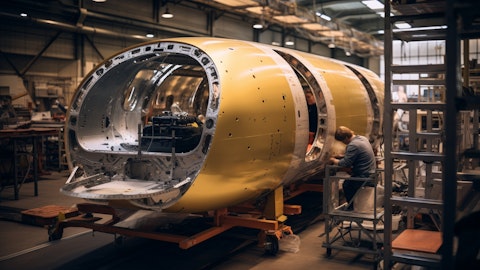StealthGas Inc. (NASDAQ:GASS) Q2 2025 Earnings Call Transcript August 25, 2025
StealthGas Inc. beats earnings expectations. Reported EPS is $0.59, expectations were $0.3.
Operator: Good day, and thank you for standing by. Welcome to the StealthGas Q2 2025 Results Webcast and Conference Call. Please be advised that today’s conference is being recorded. I would now like to hand the conference over to your first speaker today, Mr. Michael Jolliffe, Chairman of the Board. Please go ahead, sir.
Michael Gordon Jolliffe: Thank you. Good morning, everyone, and welcome to our second quarter 2025 earnings conference call and webcast. This is Michael Jolliffe, Chairman of the Board of Directors. And joining me on our call today, as usual, is our CEO, Harry Vafias, to discuss the market and the company outlook and Konstantinos Sistovaris to discuss the financial aspects. Before we commence our presentation, I would like to remind you that we will be discussing forward-looking statements, which reflect current views with respect to future events and financial performance. So please take a moment to read our disclaimer on Slide 2 of this presentation. Risks are further disclosed in StealthGas’ filing with the Securities and Exchange Commission.

Now so let’s proceed with presentation, starting with some highlights on Slide 3. And let me stress right off the bat that in a market that was trying to find its balance, we today reported our second best ever quarterly profits. These very strong results were driven by a record $47.2 million in revenues for the second quarter compared to $41.8 million last year and $42 million in the previous quarter, demonstrating the very strong performance of our commercial operations. Adjusted net income for the second quarter of 2025 was $21.7 million, 35% higher than the previous quarter, but 20% lower than last year. As I mentioned in my opening, it was the second best quarter ever. And in terms of operations of our fully owned fleet, it was actually the most successful ever.
We didn’t surpass last year’s net income record because the share of the profits we got last year from our investments were boosted by the sale of a vessel at the time. In terms of earnings per share on an adjusted basis, these were $0.59 for the quarter. While the second quarter was a period where uncertainty increased due to trade frictions, our high period coverage allowed us to improve profitability. In terms of our strategic objective of deleveraging, we have used $86 million this year to pay down the remaining debt and completed the last repayment in July. All the vessels in our fully owned fleet are debt-free. With regards to our share repurchase program, as stated in the previous call, management has spent approximately $1.8 million in buying back shares this year in what we consider a sound use of our liquidity, given that the stock continues to trade at a discount to net asset value.
We are further delivering on our strategic priorities by keeping a visible revenue stream and maintaining our period coverage for 2025 to over 70% of our fleet days while securing over $150 million in future revenues. In terms of S&P activity, we sold one vessel in the second quarter and recently entered into an agreement to sell another one, the Gas Elixir, later in the year. In the meantime, in early June, we completed the previously announced acquisition of the shares in 2 of the vessels that we already partly own through a joint venture. We will continue to look for opportunities to sell some older tonnage and possibly replace with newer tonnage. In the current third quarter, we also had an unfortunate event on one of our larger and newer vessels.
Q&A Session
Follow Stealthgas Inc. (NASDAQ:GASS)
Follow Stealthgas Inc. (NASDAQ:GASS)
Receive real-time insider trading and news alerts
In early July, our LPG carrier, the Eco Wizard, whilst loading at the port of Ust-Luga in Russia, an ammonia cargo destined for fertilizer plants in Europe, a fully compliant trade was hit by 2 explosions. None of the crew was injured. The vessel has sustained damage to the engine room and in cargo tank and it is stable. Since then, the vessel has remained at the port for investigation and temporary repairs. The indications show that the explosion were due to external devices. This is also what has been the case with other similar incidents. It is expected that the vessel will be ready after temporary repairs to depart in about a month’s time and then a plan and work scope for permanent repairs will be prepared. Due to the nature of the incident, the vessel’s relevant insurance underwriters have been notified as per the applicable policy.
Until such time that the vessel is fully repaired and able to return to operations, if at all, it will remain off par and will not generate revenue. And then we should say that indicatively during the first 6 months of 2025, the vessel generated approximately 8% of the company’s revenues. We are trying to resolve the matter as swiftly as possible, but it is a complex situation, and we don’t have all the answers yet. We will follow up with further updates as the situation progresses. Let us move on to Slide 4 of our fleet employment as of August. Since our last call, we saw more interest in period fixing from our charterers. As a result, we concluded 5 period charters, 4 of which were for one year, 3 of those were extensions and one charter was for 3 months.
That currently leaves us with 4 vessels operating in the spot market the same as in our previous call and excluding the Eco Wizard that is out of service. Two of the vessels in the spot market are the larger Handy Sizes. We continue to prefer to fix on period charters where possible, and we have managed to maintain a high period coverage of 70% of available days for 2025, securing about $48 million in revenue for the remainder of the year. One year forward coverage, we are at slightly above 60%. Total revenues secured for all future periods up to 2027 were reduced at $150 million. During the second quarter, one vessel entered dry docking in late June, and we have scheduled dry dockings for 2 more vessels for the remainder of the year. It is a fairly light year in terms of dry dockings.
However, those are being performed in the West where overall costs are higher than in the East. In terms of our fleet geography presented in Slide 5, our company mainly focuses on regional trade and local distribution of gas, while the larger vessels mostly engage in intercontinental voyages, particularly in exports from the U.S. to Europe. We now only have 2 vessels trading in the East. It is an unusually low number considering that in the past, as much as half our fleet was located there, but we have moved even more vessels to Europe since our last call. For the first time, over 70% of the fleet is trading in Europe and the Mediterranean. This is due to the disconnect in rates between Asia and Europe. We get a premium trading West of Suez, and so we are adjusting the position of the fleet.
We have discussed in the past how trading in Europe is more demanding. Nevertheless, our vessels are well maintained, adhering to all required regulations, so we feel we are in an advantageous position. And we prefer to compete with companies that follow the same high standards as our own. In terms of ammonia trading, our Handys and MGC vessels can carry this cargo, and we are optimistic for its future, although lately, the activity has been relatively low. Lastly, I once again stress that the majority of our vessels are built in Japan and some of the larger ones in Korea. No vessel in our fleet was built in China as it is one of our core policies to invest in the best quality assets available. In terms of our joint ventures, after taking into the fold the last 2 smaller vessels, we now only have one vessel under joint ownership, so we feel there isn’t a point to dedicate a whole slide to it anymore.
So we will skip straight to the financials. I will now turn the call over to Konstantinos Sistovaris for our financial performance.
Konstantinos Sistovaris: Thank you, Michael. I will discuss the financial results that were released today, starting with Slide 6, where we have a snapshot of the income statement for the second quarter and 6 months of 2025 against the same period of 2024. Due to sale and purchase transactions that took place over the period, there was a very small increase in fleet days of about 4%. Revenues were at $47.2 million for the quarter, marking a 13% increase year-on-year. Although there was a slight increase in number off-hire days from the vessels in the spot market, the majority of the vessels improved their earnings to arrive at a record quarterly profit. This result also led to record revenues for the 6-month period of $89.2 million.
Net revenues or what we call time charter equivalent revenues, both for the quarter and the 6 months were also at all-time highs. Operating expenses were $12.7 million for the quarter. Costs were contained, and this led to a mere 1.5% increase from last year, below the relative increase in the fleet. After subtracting more expense items, we arrive at the income from operations. Again, the second quarter was a record-breaking quarter at $19.7 million, a substantial 22% increase compared to last year. Interest costs at $0.6 million for the quarter were reduced by $2.1 million. Following the final debt repayment in July, the company will save completely on interest costs. Earnings from our investments in our JVs were just $0.7 million for the quarter.
There was a large reduction of $10.7 million in earnings from our nonconsolidated joint ventures. The reason is twofold. First, that there were fewer vessels as the joint ventures are wind down, and there is also a single vessel left in the joint ventures. And two, and most importantly, that last year, the majority of these earnings reflected the sale of one of the larger vessels, as you may recall. Back then, we had received a massive dividend from that sale that we had used to repay debt. Net income for the second quarter was $20.4 million,compared to $25.8 million for the same quarter of last year, a 21% decrease. Earnings per share for the quarter were $0.55 and on an adjusted basis, $0.59. This marked the second most profitable quarter in the company’s history, only surpassed by the second quarter of last year.
While this year, in terms of revenues and operational income was actually the most successful one. Looking at the balance sheet, the next Slide 7. The company continued to maintain as of June 30, strong liquidity with cash, including restricted cash of $87.3 million after having repaid $19 million in debt over the quarter and invested net about $8 million for the share in the JV vessels and while receiving $12.2 million net from the sale of one vessel. The operational cash inflow for the quarter was at $25 million. In the liability side, total debt was at $32 million, consisting of a current portion of $2.1 million and the long-term portion of $29.7 million, representing the last remaining facility that was actually later repaid in July. Shareholders’ equity increased over the 6-month period by $35.7 million to $662.2 million, a 5.7% increase.
Moving on to Slide 8 for the final update on the debt reduction strategy. As of today, the objective has been complete, and the company has repaid all its debt. Since the beginning of 2023, when our cash flow started improving considerably, and when interest rates had increased from their lows, we set out to deleverage the company, not thinking that in 2.5 years, we would, for the first time, achieve 0 debt. Since then, an impressive $348 million were used to repay the debt. During the current year, $86 million was used in repayments, $32 million of which in the current third quarter. That was the last facility and all the vessels in the fully owned fleet are now unencumbered. Only the single JV vessel remains financed, but our investments are not consolidated.
This strategy has resulted in significant interest cost savings, especially as interest rates remain stubbornly high, and that allows for significantly faster cash flow accumulation going forward and gives the company the agility to pursue other goals. I will now hand you over to our CEO, Harry Vafias, who will discuss the market and the company outlook.
Harry N. Vafias: President, CEO, CFO & Non-Independent Director Continuing on Slide 9, we’re discussing the LPG market, where despite the trade upheaval and uncertainty caused by during the Q2, the main themes we have discussed in the past are pretty much unchanged. Global LPG exports continue to register strong growth at 6.6% for the first 6 months. U.S. exports continued to increase year-on-year, albeit with ups and downs as the second quarter was actually weaker than the first quarter. U.S. terminal expansions are underway. Enterprises expanded terminal exported its first cargo in July, an ethane cargo and Energy Transfer’s Netherlands terminal expansion is expected to also come into service by the end of the year with more planned for the years ahead.
In the Middle East, where there are also projects underway to increase production and exports. We have the Iraq tenders last quarter that led to several Handy Size vessels finding business therein supporting the market. China LPG imports in May climbed to 3.4 million tons, registering a 6.7% increase. India’s demand was more muted last quarter, but the latest headlines from there are that the country plans to source 10% of its imports from the U.S., that if it happens, will definitely lead to an increase in thermal demand as India currently is a major Middle Eastern client. Finally, trade disputes are always on the agenda. In the second quarter, they did create market uncertainty. Since May, this mostly affected ethane exporting because of the export license issues, but this seems to have been resolved in July.
In the longer term, we continue to see Chinese demand being driven by the PDH plants that need LPG for propylene production. And while in the short term, more than 25% of the capacity remains off-line, plants continue being built that should underpin long-term demand. Three more we expect just this year, bringing total capacity to 27 million tons. Moving on Slide 10 to update you on the shipping market, where the picture is pretty much unchanged. The smaller vessels continue with an East West divide. The rates remain firm at high levels in Europe. In the spot market, we have seen a slight drop in activity, which is typical seasonality. A small number of new orders were placed for ’27 and ’28 deliveries, but the order book remains very healthy, while the existing fleet has a large number of older ships that sooner or later need to go, yet scrapping remains limited.
For the Handy Size ships, rates were slightly softer, and there was limited activity mostly coming from the Iraqi tenders. The order book for Handy Size remain very slim, and we don’t see new orders being placed. With no delivery scheduled for this year, we should logically support the period market. On the MGCs, the softening in Q1 continued in Q2. TC inquiries remain limited. At the time of writing, however, assisted by a strengthening VLGC market, the past few weeks, we are currently seeing a slight firming again of the MGC spot rates. The order book provides for a more limited number of deliveries in ’25, but beginning of next year, more vessels will start joining the fleet. Expectations for the next few years with a significant order book coming remains challenging.
On the plus side, although we still see a few additional orders since our last call, the pace of ordering has slowed down significantly. On Slide 11, we are outlining some of the key variables that may affect our performance in the quarters ahead. Summing up, the unfortunate development of the Eco that will keep the vessel out of employment for some considerable time will have an impact on our revenue generation for the near future. The situation is still developing, and we are committing our resources for a swift resolution. The results we have announced so far this year are excellent. Revenue growth exceeded our expectations, setting a new quarterly record of $47.2 million. We also set new records in terms of operational profits. We achieved that in an environment that was not as inviting, trade frictions have created uncertainty.
And although we did see improvements since Q1, challenges remain. Also as presented today, the chartering markets were relatively stable yet we managed to shed new records again. At the same time, during the current third quarter, we completed our strategic objective of deleveraging the company completely, having repaid $86 million in debt this year and close to $350 million of debt since we began at the start of ’23. We are confident that the fundamentals for LPG shipping continue to be positive and our company is in a very favorable position to take advantage of the rising demand. As we are now exiting the seasonally weaker summer months, we expect chartering activity to pick up in the fourth quarter. We have now reached the end of the presentation, and we’d like to thank you for joining us and for your interest and trust in our company.
We look forward to having you with us again at our next conference call for our Q3 results in November.
Operator: Thank you. This concludes today’s conference call. Thank you for participating. You may now disconnect.
Follow Stealthgas Inc. (NASDAQ:GASS)
Follow Stealthgas Inc. (NASDAQ:GASS)
Receive real-time insider trading and news alerts



